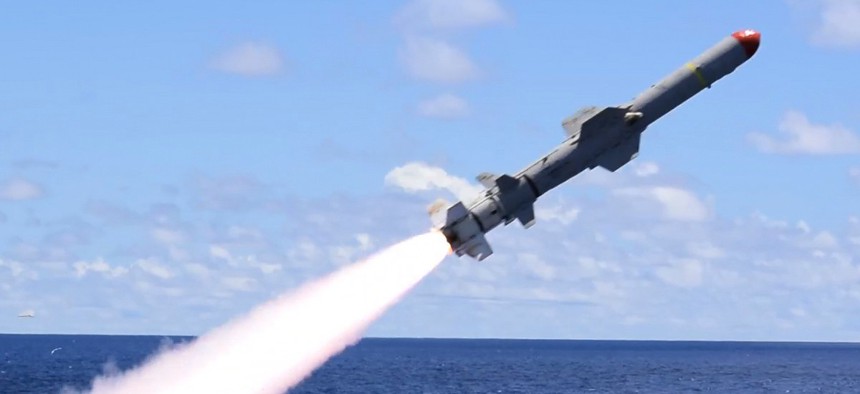The Pentagon Wants Tech to Help Allies Avoid Bombing Civilians

The USS Antietam launches a harpoon surface-to-surface missile during the Pacific Vanguard exercise. Joshua Shafe/Navy
The Defense Department is looking for technical solutions to reducing civilian casualties that can be declassified and shared with international partners.
The U.S. has a responsibility to ensure minimal civilian casualties during airstrikes, including those conducted by allies. To help with this, the Defense Department is looking for cutting-edge technologies that are just this side of classified to help international partners prevent incidental civilian injuries and death.
Per an April 2018 presidential order, it is incumbent on the U.S. to ensure military operations conducted by allies and coalition nations do not result in significant harm to civilians. To that end, the Defense Security Cooperation Agency is looking for technologies that can reduce collateral injuries and deaths during strikes—and, specifically, unclassified tech that can be shared with other countries.
“It is the policy of the executive branch to facilitate ally and partner efforts, through United States sales and security cooperation efforts, to reduce the risk of national or coalition operations causing civilian harm,” according to a request for information issued Friday.
The RFI is asking for industry feedback on the best ways to achieve two goals:
- Improve foreign countries’ capacity to effectively employ strike capabilities in a manner that distinguishes between military objectives and civilians.
- Develop and integrate principles and techniques on the protection of civilians in relevant partner force standard operating procedures, encouraging and enabling a partner to avoid civilian casualties in the context of military operations.
Specifically, the RFI is looking for technological solutions that will directly reduce the potential for civilian casualties, such as advanced targeting. These would include “unclassified software and other tools that assist with targeting and collateral damage estimates for military operations, including technology capabilities that would assist in the effective use of air-launched weapons—[precision-guided munitions] or unguided bombs—and/or analyze potential collateral damage based on a specific weapon employment scenario.”
The document offers four hypothetical cases, such as a program that could be given to a partner nation’s air force that calculates the best way to use guided missiles to avoid civilian casualties in a specific scenario.
Another use case suggests technology that would help an intelligence analyst work out the best way to use an “air-launched weapon” to destroy or disable a target. That analysis would include the desired point of impact, probability of damage, angle of attack and fusing determinations, along with a calculation of potential harm to civilians.
Since these technologies will be shared with other countries, all potential solutions must be unclassified and not subject to international restrictions. To that end, the preliminary RFI is open to anyone with good ideas and is not restricted to clearance holders.
Along with specific technical capabilities, the Pentagon is also interested in hearing about “capacity to collect, track and analyze civilian casualty data and apply lessons learned to future operations.”
Interested parties can send a capabilities statement by 1 p.m. June 14. The procurement office will also be holding 45-minute in-person briefings on June 18 and 19.
Questions on the RFI are due by 1 p.m. June 6.
NEXT STORY: Uber Riders Can’t Stand All the Air Fresheners




